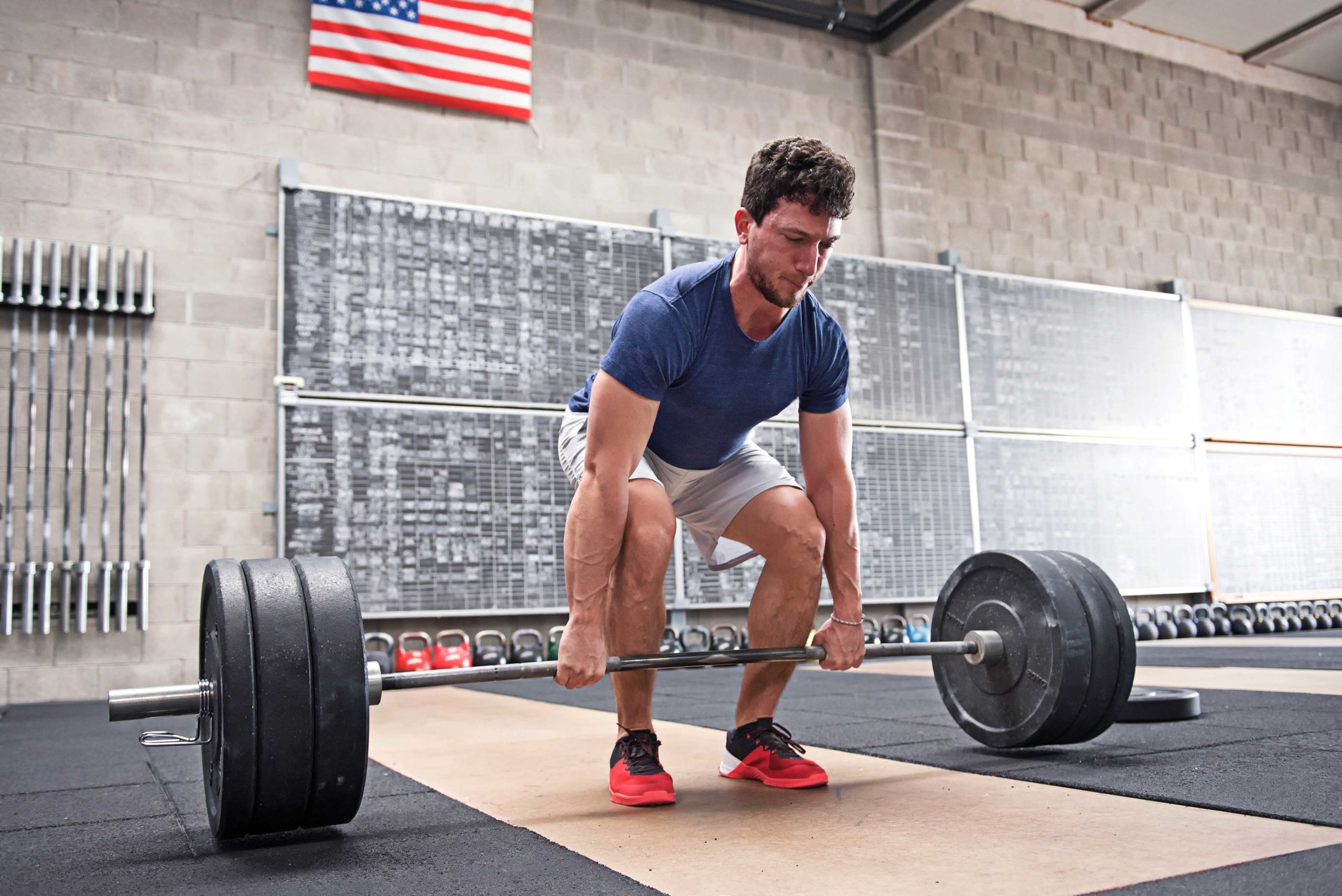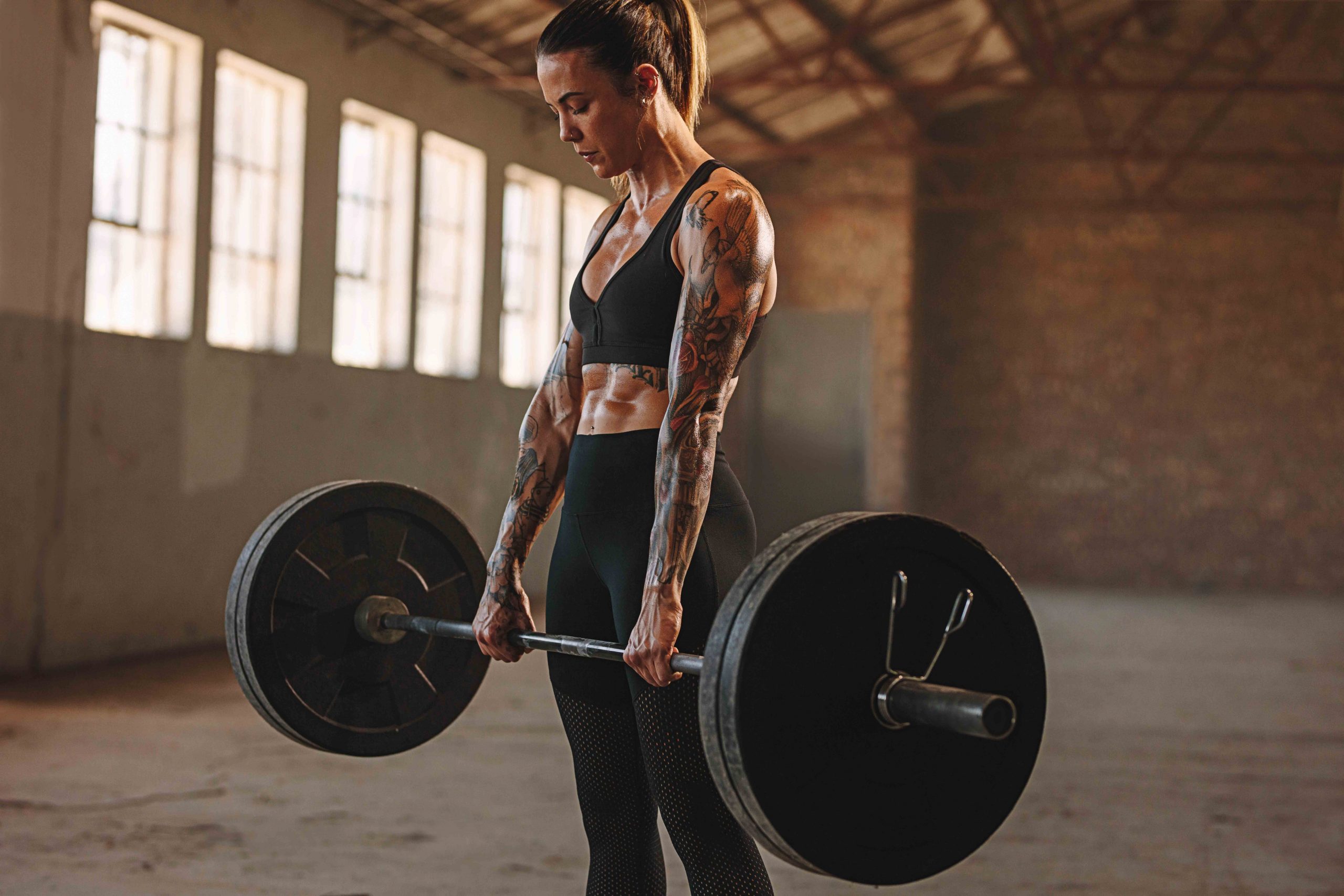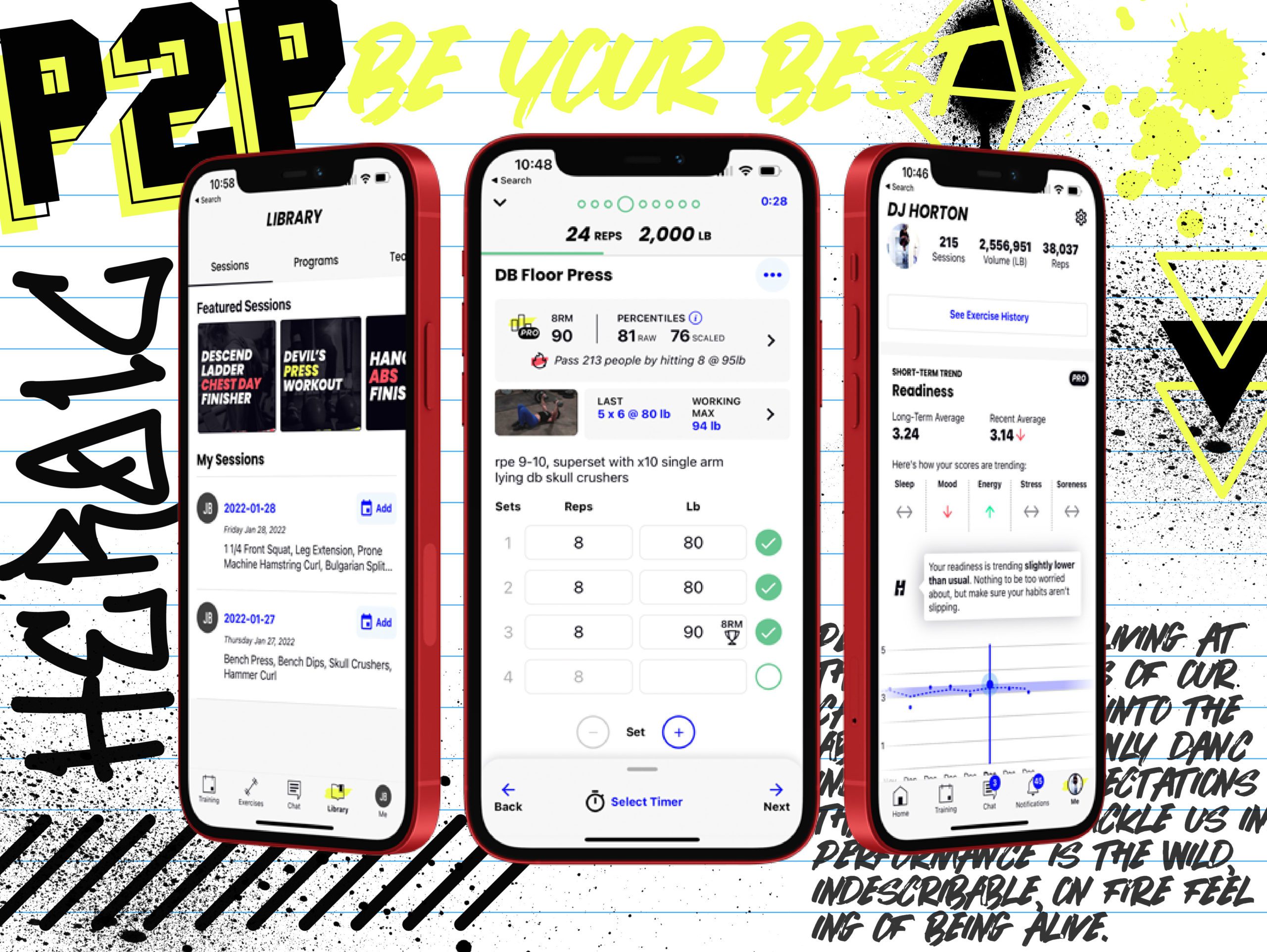6 Exercises to Defeat Your Deadlift Sticking Points

Does your deadlift get stuck on the floor, at your knee, or at your hip? What kind of drills can you use to blow through those high-gravity spots? Sari Terranova is a total supermom, CPT, and nutrition coach who introduces women and youth athletes to the power of weightlifting, bodybuilding, powerlifting, and functional strength training.
She’s got 20 years of classroom teaching experience and a lifetime of love for college football. In this blog she outlines what to work on if your deadlift is stuck on the floor, at mid-shin or if you fail lockout. Expect to learn about deficit deadlifts, reverse sled-pulls, good mornings, pause DLs, holds, and block pulls.

It’s Time to Finally Nail That Deadlift PR
We’ve all been there. You load up the bar, chalk up the palms, walk confidently over to the platform ready to crush your next deadlift PR. You set your stance and grip, then… the bar defiantly refuses to budge off the floor. Or you get it off the floor, but only manage to pull the weight mid-shin. You just can’t lock out at the top.
Regardless of the hurdle, you roll your eyes to the ceiling and shake your head in that universal “I-don’t-know-what-just-happened-I-swear-I-can-pull-this” gesture. Maybe you try to ignore some derisive stares from other lifters in the gym pretending not to watch. You let out a big sigh and start the humiliating process of pulling plates off the bar.
Here’s the good news: you don’t need to keep reliving this defeat.
There are easily identifiable muscle weaknesses associated with your specific sticking point and a number of effective accessory movements that can help you blow through them. You’ll be struttin’ into your next PR party in short time.
The deadlift is called the King of Lifts for a reason—it’s a full-body activation movement hitting the back, traps, arms, forearms, quads, glutes, hams, calves and core. Basically, it’s a conduit for all-over muscle strength and growth, while at the same time improving your posture, grip strength, and bolstering your core and posterior chain (which will pay dividends in your squat and other compound movements).
Deadlifts are also a functional movement that translate to your ability to lift objects at work or in your daily life. Just be prepared to have a dozen or so excuses handy when everyone hits you up to help move their furniture.
On days when I don’t feel like working out or I’m short on time, I know I can do a few rounds of deads and still get a complete strength-building, calorie-burning workout.
Because the deadlift is a compound lift that requires balanced strength in all of these muscle groups, a PR is not just a badge of honor, it’s a pretty accurate and universally respected indicator of overall strength. Weaknesses in any of these groups can halt our progress unless remedied.
Here are six exercises to incorporate into your program to tackle your DL nemesis.
When Your Deadlift is Glued to the Floor
If your sticking point is getting the bar off the floor, leg drive is likely the issue. The initial movement of a deadlift is quad-dominant, then the load shifts to the hips as the weight passes your knees. Strengthening your quads will give you the push you need to pull those plates off the platform.
1. Deficit Deadlifts
Deficit deadlifts are done with your feet elevated on a plate or platform (about 2-3 inches off the floor). Increasing the range of motion puts your knee and hip flexion in a more quad-dominant angle. And since you need to move the bar a longer distance, deadlift from a deficit strengthens the explosiveness of your pull off the floor.
To perform the deficit deadlift, stand on two bumper plates side-by-side with your feet in your typical stance. Keeping the bar close to your body, make sure to control your tempo during the eccentric phase as you lower the bar back to the floor. You can play around with different platform heights and rep tempo as long as you don’t compromise your back and core stability. You can also repeat the pause at the bottom of the eccentric phase if you’re really a glutton for punishment.
Start with 3-5 reps at around 65% of your 1RM. Repeat for 4-6 sets.
2. Reverse Sled Pulls
The sled is an excellent tool for developing explosive leg drive—you can easily vary weight, speed, and distance to challenge your quads in different ways. To build strength in the quads, you want to focus on a shorter distance with heavy weight. Sled pulls will torch your quads in a knee-friendly way, so this is one of the rare times that you can start heavy and reduce weight as needed.
To perform the reverse sled pull, load up the sled in a space where you have 20-40 yards of turf or drag space. Stand facing the sled and use a belt attachment (my preference to totally isolate the legs and take the upper body out of the equation) or grasp the handles of your straps and step back until the strap is taut. Keeping your back straight, squat down a bit, and step backwards, pushing your foot “through the ground” intentionally with each step. At the end of the turf, reverse direction and pull the sled back to your starting point.
Rest 60-90 seconds and repeat until you can’t. This is a great leg day finisher with sneaky cardio benefits as well.
Honorable Mentions: Safety Bar Low Box Squats, Unilateral Squat Variations, High Box Step-ups
You Work too Hard to Not See Progress
Find Your Perfect Training Plan
Options for Every Goal
Training plans from real coaches covering any goal, fitness level, and number of sessions per week.
The Best Coaches
Get coached by the best. Olympians, ex-NFL stars, Titan Games Winners, Sport Scientists and more.
Starting at $1/ day
With many options including a free 7 day trial, you can try out programming before you commit.
Midway Weakness
Losing your lift midway indicates a weakness in the glutes and lower back, as well as possible lack of lat recruitment. These exercises force you to spend extended time under tension in a proper mid-deadlift position to strengthen your upper/lower back and pump up that posterior.
3. Good Mornings
Good mornings are incredible posterior chain builders. Because of the focus on the lower back (erector spinae), it’s important to practice proper form. Start with light weight if you’re new to this movement. Preloaded barbells let you start as light as 20lbs to get your form down. Even for experienced lifters, it’s more effective to use moderate weight and higher reps for this accessory lift.
To perform the good morning, unrack the barbell as you would for a back squat. Set your feet shoulder-width apart, slight bend in the knees, and take a bracing breath. Hinge at the hips, pushing them back as you lower your torso until it is almost parallel with the ground. You should feel tension in your hamstrings. Slowly rise back to the starting position by driving your hips forward and engaging your glutes. Squeeze at the top, but don’t hyperextend your back
Perform 5-10 reps for 3-4 sets. If you need to strengthen your lower back more so than your glutes and hams, try good mornings from a seated position. If you need to focus more heavily on the hams, you can elevate the toes on a wedge or plates.
4. Pause Deadlifts
Pause deadlifts help identify your exact sticking point and develop strength in that zone by increasing time under tension at the weak spot before finishing the lift.
Using anywhere from 50-70% of your 1RM, set up the same way you would for a conventional deadlift. Pull the bar to your weak spot and hold for 2-5 seconds. Make sure the bar comes to a complete stop during the pause so you’re not using any momentum to finish the pull. Once you hit your pause, the bar should not lower at all until after lockout.
The longer the pause, the lighter the weight on the bar should be. This added time under tension at your weakest position during the lift reinforces proper position of your upper back and lat development.
Honorable Mentions: GHRs, Reverse Hypers, KB swings

Level Up Your Training
With TrainHeroic’s immersive training app
TrainHeroic does everything you wish your old gym notebook could do.
Take the guesswork out of training with built-in exercise instruction and basic training programs. Compete against yourself and others. Track your performance and readiness. Smash your goals.

Lockout Failure
Failure to lock out properly at the top of your deadlift is problematic, particularly if you are competing. Lockout failure can be linked to starting your lift in an improper position, so check that first. If your form is on point, but your lockout is weak, grip strength, upper back weakness, and hip hinge can all be culprits. Try these exercises performed the same way you would a conventional deadlift.
5. Extended Holds
If grip strength is your weakness, try holding on to the bar for an extended period of time at the top of the lift. An easy way to incorporate this into training is to finish your last rep per set with a 10-15 second static hold at the lockout.
This strategy works best on your higher rep deadlift days where you’re using about 65-75% of your 1RM.
6. Block (or rack) Pulls
If you’re relatively weak in your upper back and glutes, block pulls may be your best weapon. Block pulls are essentially elevated deadlifts—the bar is placed on blocks at or slightly under knee-height, so that the glutes, traps and upper back have their time to shine.
As this starting position results in reduced range of motion, you can overload the weight. And as we know, overload is the path to muscle growth and strength. Try 5×5 sets at a weight that’s moderately higher (around 10-15%) than your typical 5RM. You can also incorporate a modest five-second extended hold on your final rep per set to really challenge that grip strength.
Honorable Mentions: Bands & Chains, Hip Thrusts, Heavy Farmer’s Carries
Since deadlifts require a lot of muscle activation, they also require some extra recovery time. When programming your accessory lifts, make sure to insert them into days that are separated from your heavy deadlift day.
I like having a designated deadlift day (Wednesday deads are my favorite mid-week motivation boost) where I alternate weeks pulling max effort or volume, and incorporate accessory lifts into my leg and back-focused training sessions.
However you program them, proper form and consistency are key. Be sure you’re proficient with the conventional deadlift first. Our spines are precious.
If you’re ready to progress to the next level, feel free to creatively curse my name when you’re pulling those deficits… that next PR will be worth it, I promise.
Want Training Tips, Exercise Guides & Knowledge Bombs Sent to Your Inbox?
Sign up for the FitNerd newsletter from TrainHeroic
Related articles
3 Ways to Improve Mobility Without Stretching
Are you still trying the endless foam rolling and stretching exercises to get that deep squat position? We know how important mobility is for great, or even GOOD performance. All professional athletes have some comfortability in end ranges of motion. So, what else do...
The Ultimate Guide to Lunges: Queen of all Glute Exercises
Your glutes are the largest muscle group in your body. They’re responsible for almost everything your legs do—walking, running, jumping, squatting, lunging, and just standing upright. As far as moving through space goes, strong glutes are the bedrock of overall...
A Beginner’s Guide to Steel Mace Training
Author: Jesse Grund
Mace training will make you a better mover without it’s not confining you to a fixed space or predetermined range of motion. Second, it’s an offset load with 80 to 90 percent of the weight in the head. You’re also constantly having to resist rotation, which creates greater core engagement.

Join the community
Sign up for the latest training news and updates from TrainHeroic

About TrainHeroic
Support
Made with love, sweat, protein isolate and hard work in Denver, CO
© 2021 TrainHeroic, Inc. All rights reserved.






